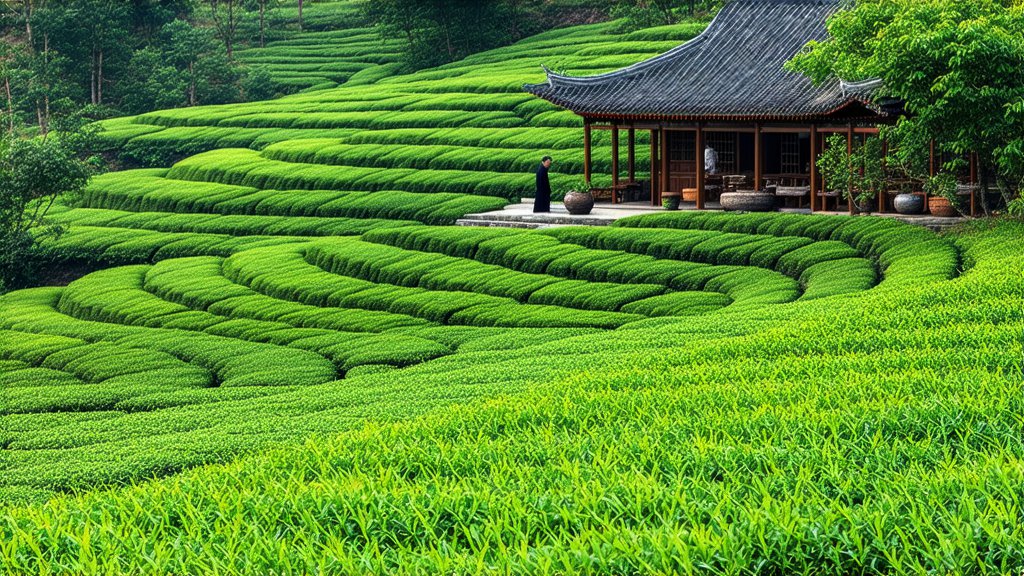
In the vast tapestry of Chinese tea culture, few varieties hold as much mystique and allure as Ti Kwan Yin, a revered oolong tea hailing from the Fujian Province's Anxi County. This exquisite brew, often referred to as the "Iron Goddess of Mercy," has captivated tea enthusiasts worldwide with its unique flavor profile, aromatic complexity, and storied history. Join us on a journey to uncover the secrets behind this enchanting tea, exploring its origins, varieties, intricate craftsmanship, and the art of its appreciation.
A Glimpse into History
The tale of Ti Kwan Yin begins in the misty mountains of Anxi, where legend has it that a poor farmer discovered the first tea plant in the 18th century. As the story goes, a compassionate goddess appeared in his dreams, guiding him to a secluded valley where these extraordinary tea plants grew. He named the tea after her—Ti Kwan Yin, or the Iron Goddess of Mercy. Over time, this divine gift became a symbol of purity, kindness, and spiritual enlightenment, transcending its humble beginnings to become one of China's most treasured teas.
Varieties and Flavor Profiles
Ti Kwan Yin is not a single tea but rather an umbrella term encompassing several distinct cultivars, each with its own character and charm. Among the most renowned are Qi Lan (Seven Immortals), Huang Jin Gui (Golden Osmanthus), and Ba Xian (Eight Immortals). These varieties differ in leaf shape, aroma, and taste, offering a delightful spectrum for tea connoisseurs to explore.
-
Qi Lan: Known for its delicate floral notes and light, crisp taste, Qi Lan embodies elegance and refinement. Its leaves are slender and twisted, resembling the form of a willow leaf, and when brewed, they unfurl gracefully, releasing a sweet, orchid-like fragrance.
-
Huang Jin Gui: This variety stands out with its rich, creamy texture and a distinctive roasted aroma, akin to that of fresh chestnuts or toasted grains. The leaves are thicker and more robust, yielding a full-bodied cup that warms both body and soul.
-
Ba Xian: True to its name, which translates to "Eight Immortals," Ba Xian boasts a complex medley of flavors, blending fruity undertones with hints of spice and a subtle smokiness. Its leaves are tightly rolled, revealing a deep green hue when steeped, and exude a captivating scent reminiscent of distant mountain forests.
The Art of Craftsmanship
The creation of Ti Kwan Yin is a testament to the artistry and precision inherent in traditional Chinese tea-making. The process involves meticulous steps that transform fresh tea leaves into the fragrant, flavorful treasure we know today:
-
Plucking: Only the tenderest buds and leaves are selected, usually during the spring and autumn harvests when the plants are at their peak vitality.
-
Withering: Freshly picked leaves are spread out thinly to wilt under the sun or in shaded areas, reducing moisture content and softening the cell walls for easier rolling.
-
Bruising: Leaves undergo gentle bruising to initiate oxidation, a crucial step that imparts the characteristic flavors and aromas of oolong tea.
-
Fixation: Heat is applied to halt oxidation, preserving the desired level of complexity and ensuring the tea maintains its vibrant color.
-
Rolling: Leaves are skillfully rolled and shaped by hand or machine, further breaking down cell structures and enhancing flavor extraction during brewing.
-
Oxidation: Depending on the desired style, the leaves may undergo additional oxidation, allowing them to develop deeper flavors and aromas.
-
Roasting: Finally, the leaves are roasted to remove any remaining moisture and stabilize the tea, resulting in a dry, crisp finish.
This intricate dance between man and nature gives birth to Ti Kwan Yin's signature qualities—a harmonious balance of complexity and purity that sets it apart from other teas.
The Ritual of Tasting
To truly appreciate Ti Kwan Yin, one must engage in the ancient practice of Gongfu Cha, or "Kung Fu Tea." This ceremonial approach emphasizes mindfulness, respect for the tea, and an intimate connection with its essence. Here’s a guide to savoring this exquisite brew:
-
Preparation: Choose a Gaiwan (a traditional Chinese teapot with a lid) or a Yixing clay pot for optimal flavor expression. Use water heated to approximately 90-95°C (195-205°F), as boiling water can scald the delicate leaves.
-
Warming: Warm the teapot and cups with hot water to enhance aroma and ensure even heat distribution. Discard this initial rinse.
-
Infusion: Place about 5 grams of Ti Kwan Yin into the pot. Add hot water, swirling gently to awaken the leaves without disturbing them too much.
-
First Brew: Steep for around 15-30 seconds, then pour the liquid into a fairness cup to evenly distribute the tea before serving into smaller tasting cups. This initial brew helps "wash" the leaves and prepare them for subsequent infusions.
-
Subsequent Infusions: With each successive brew, gradually increase steeping times by 10-15 seconds. Ti Kwan Yin can be enjoyed through multiple infusions, revealing different facets of its flavor profile with each sip.
-
Observation and Appreciation: Take note of the tea's color, clarity, and aroma. Sip slowly, allowing the flavors to unfold on your palate—from the initial floral or fruity notes to the lingering aftertaste that signals a well-crafted tea.
In conclusion, Ti Kwan Yin is more than just a beverage; it is an experience, a journey through time and tradition that connects us to the land, the people, and the spiritual legacy of Anxi. As you raise your cup to your lips, let each sip transport you to the tranquil tea gardens where the Iron Goddess herself once roamed, inspiring generations with her divine gift.